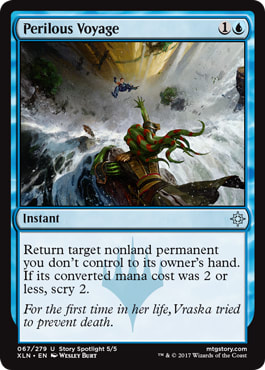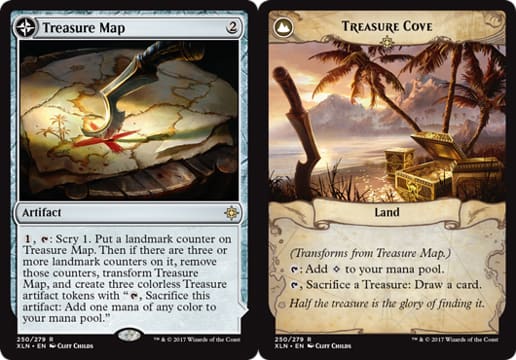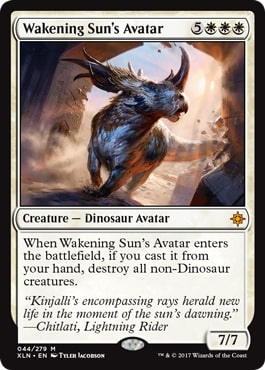Imagine for a moment you have the best main deck in the history of Magic: The Gathering. It wins 100% of Game-1s.
However this deck is weak in sideboarded games, essentially never winning.
What percentage of the time does this greatest main deck of all time win?
Interlude: Happy-Sad
I suppose you could say I was happy-sad.
I looked over at the Open match, and saw a Treasure Map in play.
"You were right," Player X said. "These really are better."

Happy?
I mean, imitation is the sincerest form of flattery. And he beat me!
Player X had beaten Yours Truly in the ![]()
![]() Approach mirror, sending me into a depressing 1-2. But I guess he bought the theory I put into my sideboarding.
Approach mirror, sending me into a depressing 1-2. But I guess he bought the theory I put into my sideboarding.
Player X signed the slip a loss, though; losing to my apprentice in . . . the . . . ![]()
![]() Approach mirror.
Approach mirror.
My friend won. Happy?
My cards lost in the matchup where they were supposed to grant a key positional advantage. That was almost like me losing. Sad?
I still don't know.
So, Happy-sad.
This is the deck I played at last month's Star City Invitational in Roanoke, Virginia:
W/U Approach -- Ixalan Standard | Mike Flores
- Instants (23)
- 1 Commit // Memory
- 1 Essence Scatter
- 1 Perilous Voyage
- 4 Censor
- 4 Glimmer of Genius
- 4 Hieroglyphic Illumination
- 4 Settle the Wreckage
- 4 Supreme Will
- Sorceries (6)
- 3 Approach of the Second Sun
- 3 Fumigate
- Enchantments (6)
- 2 Search for Azcanta
- 4 Cast Out
- Lands (25)
- 5 Island
- 5 Plains
- 3 Ipnu Rivulet
- 4 Field of Ruin
- 4 Glacial Fortress
- 4 Irrigated Farmland
- Sideboard (15)
- 3 Treasure Map
- 2 Negate
- 2 Torrential Gearhulk
- 1 Wakening Sun's Avatar
- 4 Authority of the Consuls
- 3 Regal Caracal
The main reason I played this deck is that I thought it was the best Game 1 deck in the format. The secondary reason was Roman Fusco's discovery of Perilous Voyage. That card is really cool and really fast! It gave us an upside solution to a permanent in play -- anything from Search for Azcanta to God-Pharaoh's Gift -- but most compellingly broke the Gideon fight. Previously, Approach decks had to fight a Gideon emblem primarily by hiding Gideon of the Trials itself with Cast Out. It's not that that isn't a solution . . . It's that the opponent can almost, by definition, fight you right back by Casting Out your Cast Out. Perilous Voyage simply gave us a way to circumvent the Cast Out war while dealing with a Longtusk Cub on the draw (with value).
For a deck with a bunch of cards that can remove Hazoret the Fervent from play -- bouncing and exiling both -- Approach is kind of bad against Red Aggro. On the other hand, the then-hotter Treasure Red matchup is much easier, plus I felt like the deck was a mortal lock for Energy.
Certainly, I was ahead against Energy in the main.
Your mileage could vary in sideboarded games; but that's the point of this article and we'll get to that in a bit.
I liked the ![]()
![]() deck I posed in How to Play Against Hostage Taker best prior to the Invitational but kept getting time limit draws in paper games. Anyway, porting the Treasure Map tech to
deck I posed in How to Play Against Hostage Taker best prior to the Invitational but kept getting time limit draws in paper games. Anyway, porting the Treasure Map tech to ![]()
![]() gave me the kind of edge in otherwise predictable matchups that I have lusted for my entire career.
gave me the kind of edge in otherwise predictable matchups that I have lusted for my entire career.
Treasure Map is a powerful multi-dimensional enabler. It's similar to Search for Azcanta, but arguably better. It's not-better insofar that as a main deck card it presents an Abrade target, but it's not-worse in most other ways.
Treasure Map not only flips quickly, it flips while actively assisting you.
It can help dig for your second Approach after you've cast the first one (though admittedly more weakly than Azcanta, the Sunken Ruin); but most importantly can accelerate your first Approach while helping to provide cover.
It also helps to cast Wakening Sun's Avatar in certain sideboarded games!
Standard is about a quarter Temur Energy right now, and Day Two of the Invitational was even more dramatic. I didn't play any, though; beating a Sultai Energy, losing the U/W mirror twice (despite drawing my Treasure Maps), and then going down to Mono-Red in a way that inspired a big chunk of this article.
You might have noticed my deck has some new things (Treasure Map, Field of Ruin times FOUR) but also lacks others... Most notably Disallow.
I thought my Game 1 in the U/W mirror was excellent from MTGO testing; Three copies of Ipnu Rivuet gave me a way to pressure the opponent into action + win games not directly defined by a second Approach of the Second Sun. Field of Ruin times FOUR let me largely ignore an opposing Search for Azcanta.
But I lost both my rolls in the ![]()
![]() matchups, and when the opponent can cast the first Approach (whether it resolves or not) and can dig for Disallow late when you can't . . .
matchups, and when the opponent can cast the first Approach (whether it resolves or not) and can dig for Disallow late when you can't . . .
There is a Lesson Here: What You Need to Know About Sideboarding
Imagine, for a moment, you have the best main deck in the history of Magic: The Gathering. It wins 100% of Game 1s.
However this deck is weak in sideboarded games, essentially never winning.
What percentage of the time does this greatest main deck of all time win?
The snap-answer most players will give is around 50%. It wins all the first games, right?
Those that think a little deeper will realize 50% is too high. Less than half of matches will be resolved in two games.
It turns out, for this conjectural deck, way less than 50%.
Every match goes to three games. You win Game 1, but lose Game 2; forcing Game 3. The, under the conditions we've presented, you always -- always -- lose Game 3.
If they test at all, most players test main deck. After all, you pretty much play a main-deck game each match.
What many players miss, however, is the importance of testing sideboards. In half of naturally concluding matches, you will play half your games sideboarded. But that's only half! In matches that go three games, you play two sideboarded games and only one main deck game.
The conclusion is obvious: It is at least as important to know your matchups sideboarded. It is arguable that it is twice as important! That means not only knowing your own deck and the capabilities of its extra fifteen cards, but how your opponents and their various archetypes might present, as well.
Present
"The problem with Approach," Sam said, "is that you don't present a deck in Games Two or Three. I mean, unless you found something we didn't."
Sam was sitting next to me at the 1-1. I flashed Wakening Sun's Avatar.
Wakening Sun's Avatar is super great against at least some Temur or Four-color decks. It depends on how the opponent sideboards.
I think most Energy players tend to remove Essence Scatter if they have them. I mean, you have no creatures main deck and it's not like Regal Caracal is scaring them. They tend to bring in Negate, which weakens the sweepers that dominate Game 1 and can stop your unconditional win via Approach of the Second Sun.
Wakening Sun's Avatar is more powerful than almost any of a Temur deck's creatures on the board and can't be Negated and kills everybody and can defend well. It is a great example of . . .
Rock, Paper, Scissors
One of the potential objectives of sideboarding is to shift your rock-paper-scissors position. Approach dominates Temur in Game 1. Temur is mostly dudes, and might have one Commit // Memory total to interact with Approach itself. Approach is just a bunch of sweepers and other efficient interaction. At the seven, it has a card that says "win the game" while gaining big chunks of life.
Temur's objective -- largely -- is to shift out of this dominated position. By removing inefficient creature removal Temur increases the average quality of its draws. Specifically, it increases this quality with cards like Negate, which stop all the big trump cards -- most importantly Fumigate and Approach of the Second Sun -- that the ![]()
![]() deck uses to win.
deck uses to win.
The sideboard I presented above understands this. It gets Negate is coming in. Maybe three. Sometimes even four! So playing a card like Wakening Sun's Avatar -- especially for a deck that is designed to play thirteen turns -- makes sense from two different directions. Further, cards like Treasure Map decrease the efficacy of one-for-one interaction like Negate. Sure, you countered my key spell, but I am just going to draw another.
Consider the finalist deck's from the Invitational (one of them was Sam's):
Eli Kassis -- Ixalan Standard | Eli Kassis
- Creatures (22)
- 2 Bristling Hydra
- 2 Vizier of Many Faces
- 3 Glorybringer
- 3 Servant of the Conduit
- 4 Longtusk Cub
- 4 Rogue Refiner
- 4 Whirler Virtuoso
- Planeswalkers (2)
- 2 Chandra, Torch of Defiance
- Instants (8)
- 1 Magma Spray
- 1 Spell Pierce
- 2 Lightning Strike
- 4 Harnessed Lightning
- Sorceries (6)
- 2 Confiscation Coup
- 4 Attune with Aether
- Lands (22)
- 2 Forest
- 2 Island
- 2 Mountain
- 2 Rootbound Crag
- 2 Sheltered Thicket
- 4 Aether Hub
- 4 Botanical Sanctum
- 4 Spirebluff Canal
Four-Color Energy -- Ixalan Standard | Sam Black
- Creatures (22)
- 2 Bristling Hydra
- 2 Glorybringer
- 2 The Scarab God
- 4 Longtusk Cub
- 4 Rogue Refiner
- 4 Servant of the Conduit
- 4 Whirler Virtuoso
- Planeswalkers (5)
- 2 Vraska, Relic Seeker
- 3 Chandra, Torch of Defiance
- Instants (7)
- 1 Abrade
- 2 Magma Spray
- 4 Harnessed Lightning
- Sorceries (4)
- 4 Attune with Aether
- Lands (22)
- 1 Island
- 1 Swamp
- 2 Forest
- 2 Mountain
- 1 Blooming Marsh
- 1 Sheltered Thicket
- 3 Rootbound Crag
- 3 Spirebluff Canal
- 4 Aether Hub
- 4 Botanical Sanctum
If you swapped out some Censors and the Perilous Voyage for Treasure Map and the big dinosaur you'd probably be okay against Eli's deck. You might get caught by Spell Pierce in Game 1 but you generally have a huge advantage. He has a weird mix of permission spells but only one Negate. Certainly Eli's deck gets better against you in sideboarded games than you get against him, but your plan anticipates this by adding speed, card advantage, and the ability to grind past single exchanges.
But what about Sam's deck?
Three Negates and a Spell Pierce are now backing up Vraska, Relic Seeker. This is a disaster! Are you supposed to bring in Negate? Heavy up on Torrential Gearhulk?
How do sweepers work?
Same number of creature spells in each deck, but I'm not even sure Wakening Sun's is all that impressive against Sam.
Volatility and Card Advantage
The other key issue with the sideboard here is devoting half of it to the Red matchup.
That is almost table stakes for a ![]()
![]() , given Game 1s. Theoretically life gain is great. Authority of the Consuls is almost unbeatable if it comes down on turn one (oddly highly beatable coming down on turn two or three, though).
, given Game 1s. Theoretically life gain is great. Authority of the Consuls is almost unbeatable if it comes down on turn one (oddly highly beatable coming down on turn two or three, though).
Regal Caracal is neither fast nor particularly Hazoret-proof; but a huge redundancy in life gain and slowdown can help you buy the time you need to build the advantages the opponent doesn't have.
Unless . . .
The sideboarded games are just so gosh-darn volatile. turn one Authority you win? Unless Ferocidon? Unless a card almost all the Red mages play (and many play main deck)?
You can have salivated over your opener, thinking you were going to gain two life a bunch of times while slowing down all these haste threats. Instead you're only doing the slowdown thing; multiple copies of Authority of the Consuls don't do anything. Heck, the front side of your seven is neutered by this 3/3. Subtly, your other sideboard card swings very far in the opposite direction if there is already a Ferocidon on the battlefield.
Shelf Life
I hope you read this as something more than why most Pros avoid ![]()
![]() Approach decks.
Approach decks.
In particular, the specifics are going to be turned on their ears soon with Rivals of Ixalan . . . I just thought it an accessible lens.
Rather, think about the value of sideboard preparation relative to main deck preparation, and -- perhaps more importantly -- the mercurial value of certain sideboard strategies depending on the specificity of the opponent's focus, versus, say, switching metagame position or radically diminishing the value of highly sought after opening-hand cards.
LOVE
MIKE






























